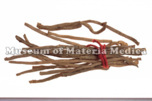Achyranthes Root

|
Market name:懐牛膝 Photo location:Museum of Materia Medica, Inst. of Nat. Med. TMPW No.:609 |

|
Plant name:Achyranthes bidentata Photo location:Sichuan Prov., China Photo date:1995 Photographer:K. Komatsu |
| Synonym | |
| Latin name | Achyranthis Radix |
| Botanical source: Family name | Amaranthaceae |
| Botanical source: Plant name | - Achyranthes bidentata Blume (IPNI:58678-1) - Achyranthes fauriei H.Léveillé et Vaniot (IPNI:58726-1) |
| Part used | Root |
| Empirical criteria for quality selection | Good one is long, enlarged, dense, soft and yellowish-white in color. Chinese ones are high quality (TN). |
| Constituents | Triterpenoid saponins: Saponin, whose genin is oleanolic acid Sterols: β-sitosterol,stigamasterol Ecdysones & Phytoecdysones: A. bidentata, A. longifolia: Ecdysterone, Inokosterone C. officinalis: Cyasterone Other: K-Succinate,K-Oxalate,γ-Aminobutyric acid |
| Pharmacological effects | Antiallergy and antiosteoporosis. |
| Indications | As a diuretic and painkiller, for removing blood stasis and inducing menstruation, it is applied to treat menstrual disorder, blood stasis, arthritis of lumbar and knee joints, paralysis, edema and oliguria. |
| Diseases | Menorrhalgia, Extension of menstrual cycle, Amenorrhea, Intra-abdominal tumor, Dystocia, Retention of the placenta, Swelling and pain due to contusion, Swelling and pain of joint, Heaviness and powerlessness in lumber and knee, Lower back pain, Edema, Urodynia, Dysuria, Hematuria, Nasal hemorrhage, Hematemesis, Hemoptysis, Swelling and pain of the root of tooth, Stomatitis, Bleeding from root of tooth, Headache, Vertigo, Stagger |
| Formulas | ishoho , kamishimotsuto , kyukichoketsuindaiichikagen , goshitsusan , goshajinkigan , sesshoin , sokeikakketsuto , daibofuto |
| Meridian tropism | Liver, Kidney |
| Property | Neutral |
| Flavor | Achyranthis Radix: bitter, sour and Cyathulae Radix: sweet, slightly bitter |
| Classification in "Shen-non Ben-cao Jing" | Superior |
| TCM: Classification | Drugs for regulating blood conditions |
| TCM: Medicinal effects | To replenish the liver and the kidney, to strengthen the tendons and bones, to eliminate blood stasis and stimulate menstrual discharge, and to lead blood to flow downward. Used for soreness of the lumbar and knee joints with weakness in the legs, amenorrhea with mass formation in the abdomen, dizziness due to hyperactivity of the liver. |
| Remarks | Listed in the Japanese Pharmacopoeia 18th ed. Sengoshitsu (Chuanniuxi in CN; Cyathulae Radix) is the root of Cyathula officinalis Kuan of family Amaranthaceae. It is both cultivated and found wild in Sichuan Province. It is listed in The Pharmacopoeia of The People's Republic of China (2015 ed.). It is used for activating blood and restoring menstruation, strengthening joints, and curing strangury by inducing diuresis. It is applied for amenorrhea with mass formation in the abdomen, retention of placenta caused by stagnation of blood stasis, palsy of joints, weakness in the legs and muscle, hematuria and bruises. Chuanniuxi is also called Quantianniuxi, Mixinniuxi, Yunniuxi, Guainiuxi and Tianniuxi. Many plants of genus Achyranthes are used as Nuixi locally, which are called Tuniuxi. |
| References | TN: T. Namba & Y. Tsuda ed., Outline of Pharmacognosy, a Textbook, 3rd ed., Nankodo Co., Ltd., Tokyo, 1998. |
DNA sequences of medicinal plants
| Gene Region | |||||||||||||||||||
| Nuclear | Chloroplast | Mitochondria | |||||||||||||||||
| Botanical source: Plant name | 5Ss | 18S | ITS1 | 5.8S | ITS2 | 26S | others | trnH-psbA | matK | trnK | trnK-rps16 | trnT-L | trnL | trnL-F | rbcL | rpoC1 | ndhF | others | |
|
|
|||||||||||||||||||
|
|
|||||||||||||||||||
